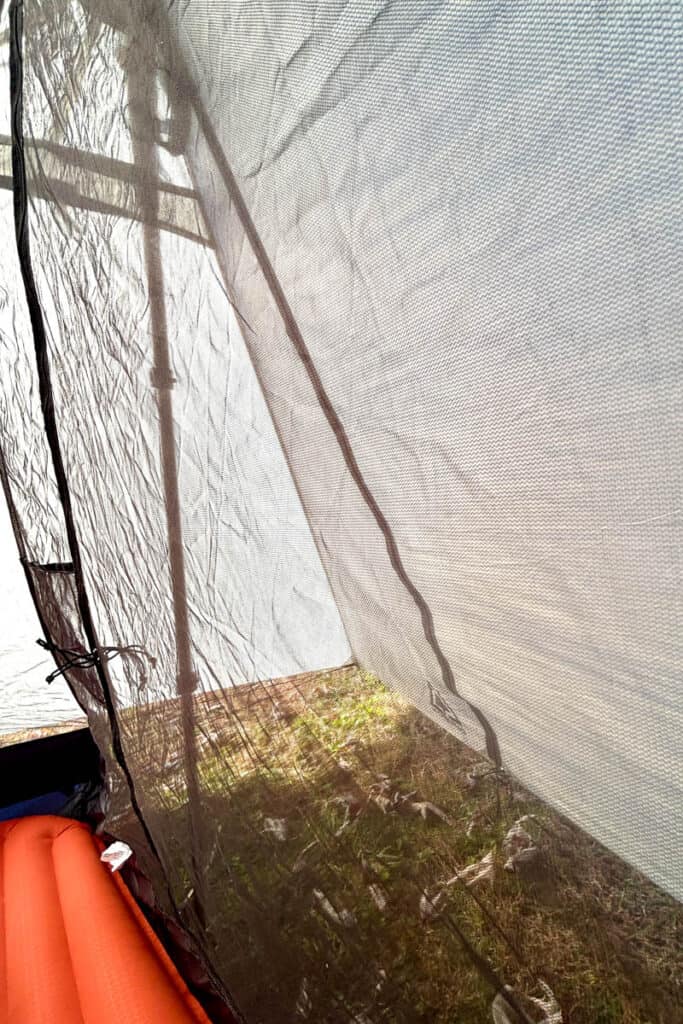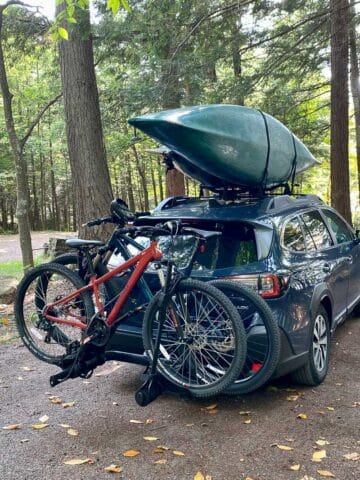This ultralight tents review compares two popular high-end backpacking tents, the Durston X-Mid2 and the TarpTent Double Rainbow DW.
This review is not sponsored and we paid for the products we tried.

If you love to backpack, you know that your tent can make a big difference in how much you enjoy yourself in the backcountry.
That's especially true with inclement weather.
After a five-day backpacking trip in Colorado's Weminuche Wilderness (with lots of rain), we decided that the single-walled, budget backpacking tent we used did "just okay". It performed decently well, but we did wake up each morning to water seeping into the tent from condensation.
We decided to test out some higher-end double-walled, two-person backpacking tents to see how they performed.
In particular, we tested the Durston X-Mid 2 and the TarpTent Double Rainbow (DW), and now we're giving you the results of this ultralight tents review!
Looking for more gear advice? Check out our tent shopping guide, our favorite backpacking gear, hiking sandal recommendations, and favorite backpacking packs for petite women.

Single-Walled Vs Double-Walled Tents
Before we get into this ultralight tents review, let's have a couple of definitions.
Single-walled tents use a single piece of fabric for the tent wall.
These tents are often more lightweight, especially ones made with Dyneema fabric. However, in general, single-walled tents are more likely to have issues with condensation dripping water into the tent. This is more of an issue with backpacking tents (compared with larger tents), because your head, body and gear are often closer to the tent walls.
Double-walled tents use two pieces of fabric for the tent walls, with the inner wall generally being some type of mesh netting. The extra lining helps prevent you (and your gear) from bumping into a wet tent wall.
Another phrase you'll run into when tent shopping is "bathtub floor". This means that the waterproof floor extends slightly up the sides of the tent, rather than having a seam in between. It's more efficient at keeping water out.
Ultralight Tents Review: X-Mid 2 + Double Rainbow DW Similarities
The two tents we tested have quite a bit in common. It's one of the reasons it was hard to choose between them!
Here are some of the similarities:
- Both tents are ultralight and double-walled
- Both fit our Exped double-sized sleeping mat
- Both use 20D polyester for the rainfly, a high-end, water resistant material
- Both are 3-season tents
- Both can utilize trekking poles
- Both include vestibules, which I like to use to store shoes
- Both are made of somewhat muted colors

Durston X-Mid 2 Review
My overall impressions of the Durston X-Mid 2 were quite good!
Note that this tent requires two trekking poles.
I was happy to find that my shorter-than-standard women's trekking poles work well with this tent, as long as they're positioned handle-side down. Standard-length trekking poles, such as the Black Diamond poles pictured below, can be positioned either handle up or down.
Durston does sell a pole system for the tent if you want to use that instead.

The X-Mid 2 is extremely lightweight, at only 40.5 ounces. (This is the combined weight for the tent, eight stakes, and the stuff sack.)
We liked that the X-Mid 2 comes tape-sealed, so there's no need for additional seam-sealing.
It comes with roomy vestibules, which I find perfect for storing muddy hiking boots or sandals.

When we purchased the tents, the X-Mid 2 was less expensive than the Double Rainbow. It was about $100 less, and the difference could be even more depending on upgrades or add-ons to the Double Rainbow.
The X-Mid 2 is asymmetrical (which at first I found odd), and there may be a slight learning curve to assembling it. If you opt for this tent, make sure to practice putting it together before taking it to the backcountry.

Now for the more subjective differences.
To me, the asymmetrical design felt so roomy! With two people inside, we still had room for two large backpacking packs (one placed at each end). We felt less squished in this tent than in the Double Rainbow.

This tent is also the taller of the two, so there’s more headroom for sitting up.

The X-Mid 2 includes a gear pocket on the top of the tent, which is great for storing a headlamp as a lantern. (The Double Rainbow has a top gear pocket as an add-on option, but I didn't remember to add that to the order to try it out.)
This tent felt more breathable than the Double Rainbow. The mesh begins lower on the bathtub area of the tent floor, and it seemed there was more airflow available. However, it was possible to tighten the rainfly to allow less airflow, which would be nice in cold conditions.

In the photo above, you can see that the X-Mid 2 (in the foreground) has a black bathtub floor and then the mesh begins immediately above that. The Double Rainbow (back right) has a strip of solid fabric above the black bathtub floor, which seemed to allow less airflow.

TarpTent Double Rainbow DW Review
The TarpTent Double Rainbow DW is a great choice for a backpacking tent. Note that TarpTent also makes a single-walled version of the Double Rainbow.
This tent does not require trekking poles, but it can utilize them to create a roomier vestibule area or to allow for a free-standing tent setup. In contrast, the X-Mid 2 cannot be setup as a free-standing tent, so this is a major point for the Double Rainbow.
However, if you do intend to set the Double Rainbow up as a free-standing tent, you'll need two standard-sized trekking poles. My shorter women's sized trekking poles are too short for this option.
The Double Rainbow DW is extremely lightweight, at only 41.1 ounces (if you opt for the carbon fiber pole upgrade).
Speaking of upgrades (and add-ons), this tent has quite a few. The standard price includes aluminum poles, but you can upgrade to lighter carbon fiber poles.
Other add-ons include extra gear pockets and seam-sealing. This tent is not pre-sealed (unlike the X-Mid 2).
This tent is smaller than the X-Mid 2, so if you’re camping in areas with extremely tight spaces, that might be an advantage. (Neither tent is large though.)
Now for the more subjective differences.
With two people and two backpacks inside, this tent felt fairly cramped. That said, there was enough room!

Also, we could've opted to store our backpacks outside the tent in the vestibule area for more space inside.

As mentioned above, I felt that the air was a little stuffy in the Double Rainbow, especially when compared with the X-Mid 2.

Ultralight Tents Review: Final Thoughts
Overall, for our specific needs, we enjoyed the X-Mid 2 slightly more.
This is partly because we prefer to store our bags inside the tent instead of in the vestibule, and in the Double Rainbow we felt a little squished. Also, with all of the ventilation open and the vestibules zipped shut, on warm nights we wished the Double Rainbow was more breathable.
However, if you don’t typically use trekking poles, or if you do use them and want a free-standing tent, the Double Rainbow would likely be a better choice.
However, both tents are solid little things, and neither would be a bad purchase!






Leave a Comment: